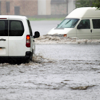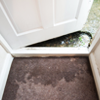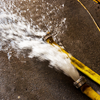Floods are the most common natural disaster in the United States. And whether you live in a high-risk area or a moderate to low risk area, you are susceptible to experiencing flooding some point in your lifetime. Within the past five years, all 50 states experienced floods and flash floods. And if you think you’re covered with homeowners’ insurance, think again, because homeowners’ insurance does not cover flood damages.
Floods vs Flash Floods
 The major difference between a flood and a flash flood is a flash flood generally develops within six hours, whereas floods take longer to develop and can last several days or even weeks. Regardless of how rapidly the water rises, both long-lasting floods and flash floods can leave behind a trail of costly damages to your home.
The major difference between a flood and a flash flood is a flash flood generally develops within six hours, whereas floods take longer to develop and can last several days or even weeks. Regardless of how rapidly the water rises, both long-lasting floods and flash floods can leave behind a trail of costly damages to your home.
Open Up the House
 After a flood occurs, it is time to start drying out your home. If there is lower humidity outside than in your home and weather permitting, open all windows and doors. Open closet and cabinet doors and remove drawers to help the air circulate. Fans also help air circulate, and if you own a dehumidifier, use that to decrease the moisture. By taking these precautions, you’re reducing the degree of wood swelling, warping, and rotting. It also slows down the growth of mold and mildew.
After a flood occurs, it is time to start drying out your home. If there is lower humidity outside than in your home and weather permitting, open all windows and doors. Open closet and cabinet doors and remove drawers to help the air circulate. Fans also help air circulate, and if you own a dehumidifier, use that to decrease the moisture. By taking these precautions, you’re reducing the degree of wood swelling, warping, and rotting. It also slows down the growth of mold and mildew.
Clean Those Walls
 The next step in your flood cleanup is washing your walls, shelves, and floors. First rinse off the walls with water and then treat with cleaner and/or disinfectant. This process will reduce the mold and mildew growing from the flood water. The only thing fuzzy and growing in your home should be your pets.
The next step in your flood cleanup is washing your walls, shelves, and floors. First rinse off the walls with water and then treat with cleaner and/or disinfectant. This process will reduce the mold and mildew growing from the flood water. The only thing fuzzy and growing in your home should be your pets.
Structural Damage
 If your basement is filled or almost completely filled with rain water, take caution during clean up. When pumping the water from your basement, only pump two to three feet and then mark a line were the water levels out on the wall. Check the water level the next day. If the water surpasses the level marker, your basement is not ready to be pumped. Check again the following day and if the water is no longer rising, pump another two to three feet of water. Repeat this process until all of the water is pumped out of your basement. Your basement should not be drained all at once because the flooded ground outside could be applying pressure to your basement walls. The water in your basement actually equalizes the pressure on your walls, lessening the risk for cracking floors, walls, and an overall weak foundation.
If your basement is filled or almost completely filled with rain water, take caution during clean up. When pumping the water from your basement, only pump two to three feet and then mark a line were the water levels out on the wall. Check the water level the next day. If the water surpasses the level marker, your basement is not ready to be pumped. Check again the following day and if the water is no longer rising, pump another two to three feet of water. Repeat this process until all of the water is pumped out of your basement. Your basement should not be drained all at once because the flooded ground outside could be applying pressure to your basement walls. The water in your basement actually equalizes the pressure on your walls, lessening the risk for cracking floors, walls, and an overall weak foundation.
Flood Aftermath
 The aftermath of water damage, whether from a flood or flash flood can be extremely costly. When cleaning your home, always be aware of any electrical or structural damage that could result in injury. If unsure of the condition and safety of your home, contact a local building inspector to assist you.
The aftermath of water damage, whether from a flood or flash flood can be extremely costly. When cleaning your home, always be aware of any electrical or structural damage that could result in injury. If unsure of the condition and safety of your home, contact a local building inspector to assist you.